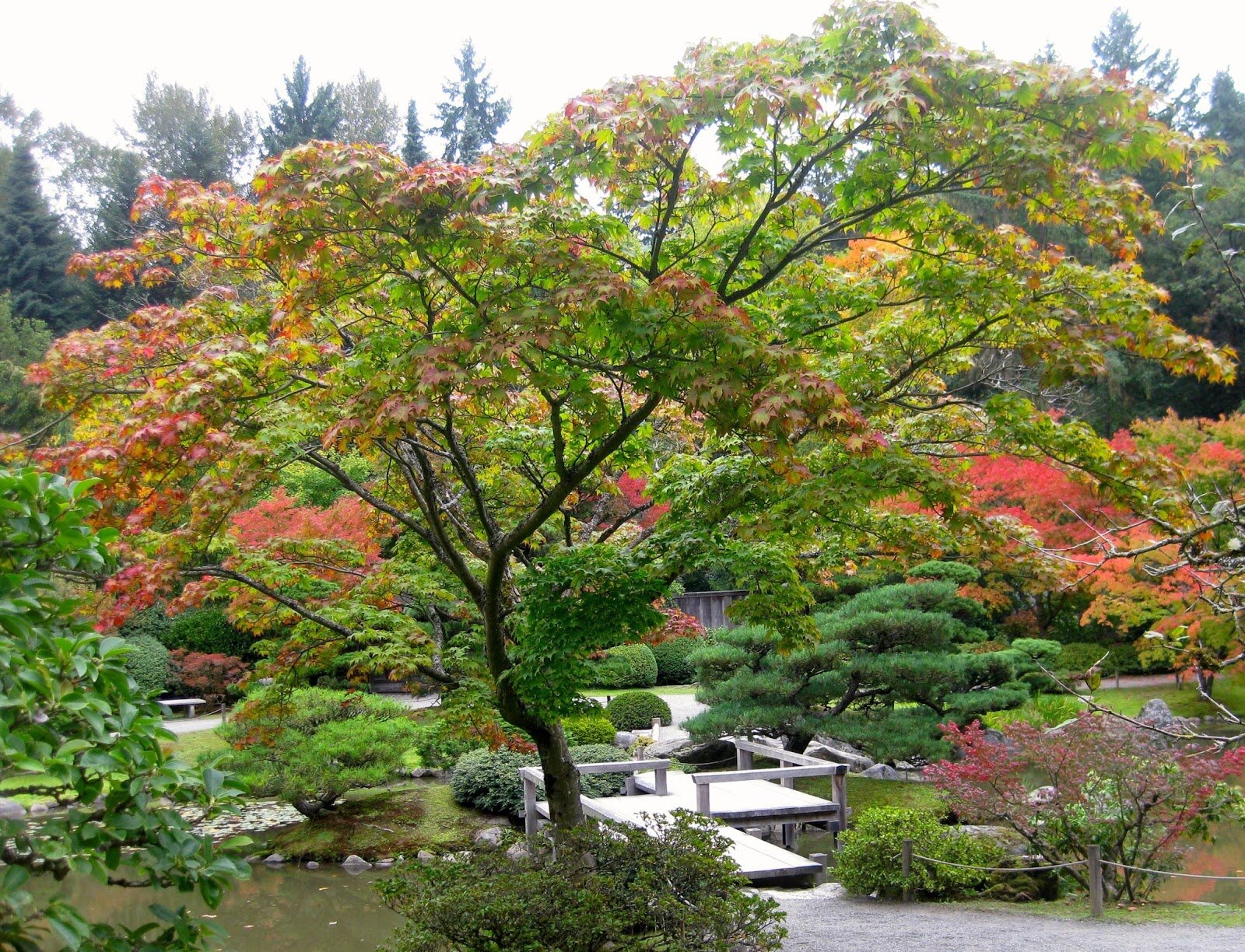'Samidare' Japanese Maple Has Beautiful Fall Leaves, Colored Like Stained Glass
By Corinne Kennedy
Acer palmatum ‘Samidare’ in Area Q, next to the zigzag bride. (photo: Aleks Monk, 2012)
Acer palmatum ‘Samidare’ is a Japanese maple notable for its uniquely beautiful fall color. Green-leaved in summer, this cultivated variety (cultivar) comes alive in autumn, with striking foliage variations of patterning and color – intricate blends of gold, crimson and purple. It’s not often seen in our area, so the Seattle Japanese Garden is fortunate to have one plant, located just west of the zigzag bridge. Received by the Washington Park Arboretum in 1966, it was part of a major maple collection donated by Rod Searles of Indianapolis. After being grown on for several years, it was planted in the Garden, next to the zigzag bridge, in April 1971 – a decade after the 1960 opening.
‘Samidare’ is included in the Amoenum Group, one of many groups (including Palmatum, Matsumurae, Linearilobum and Dissectum) that are used to categorize Japanese maple cultivars. This system is useful for distinguishing among the hundreds that have been developed, not only in Japan, but throughout the world, with new introductions continuing to be made. The Amoenum Group is one of several categories based on how the leaf lobes are divided. Trees in this group have leaves with 7-9 broad, finely toothed lobes. They are shallowly to moderately divided – up to 2/3rd of the way to the leaf base. A good example is ‘Osakazuki,’ renowned for its vivid crimson fall color.
Acer palmatum ‘Samidare’ seen to the right of the bridge during Maple Festival (photo: Chie Iida, 2019)
It’s unclear why this particular cultivar was given the name samidare, which means “early-summer rain.” A reference to Japan’s rainy season, which begins in early summer, it’s a poetic but rather mysterious allusion. Perhaps the country’s seasonal transformation from spring to early summer seems to foreshadow the cultivar’s later transformation from tranquil summer green to luminous fall color. In any event, ‘Samidare’ is a vigorous, sturdy, and durable tree, hardy to at least USDA Zone 6 (minimum temperature -10 degrees F.) It grows quickly when young, with thick young branches and an upright habit. Growth soon slows, however, resulting in a Japanese maple of medium size at maturity (about 20-25 years) – 13-20 feet tall and wide, with a round-topped form.
‘Samidare’ has broad, palm-shaped leaves that are large (about 3 inches long and up to 5 inches wide) and thick textured. They consist of seven (occasionally five) lobes with very finely toothed edges and blunt tips. The lobes are divided less than halfway to the center and radiate outward – unlike the downward angle of some maple leaves. The leaf stems (petioles) are firm, slender and 1 ½ to 2 ¾ inches long.
The beautiful fall color and patterning of ‘Samidare’ Japanese maple. (photo: Aleks Monk)
In spring, leaves emerge almost pink but quickly turn deep green with light reddish margins. In summer, the substantial foliage remains rich green without burning, even in full sun, so long as moisture is adequate. Autumn brings the striking leaf colors and patterning that characterize this cultivar – varying blends of gold, crimson and purple. Many leaves display a subtle pattern of gold-green centers and red-purple lobes.
Like most Japanese maples, ‘Samidare’ grows best in moist, fertile, well-drained soil, in part shade or sun (but not reflected heat). Best foliage color develops when grown in full sun, which it tolerates well here in the Pacific Northwest. During our dry summers, it requires regular irrigation.
‘Samidare’ is a lovely and unusual Japanese maple well worth searching for, but it may only be available as a young plant from a limited number of specialty mail order nurseries. Fortunately, the history of the Seattle Japanese Garden’s tree provides some insight into its presence here despite that rarity. Rod Searles was a maple collector in Indianapolis who purchased many Japanese maples, some directly from Japan. He learned, however, that he could not grow them outdoors in his climate. In 1966, Seattle’s Washington Park Arboretum was the recipient of his generous donation of 79 trees, including the ‘Samidare’ planted a few years later in our Garden. Its rarity in the United States, and the story of how it came to the Garden, makes me appreciate this special tree all the more.
Corinne Kennedy is a Garden Guide, frequent contributor to the Seattle Japanese Garden blog, and retired garden designer.



